And Yet It Moves, Marta R. Stoeckel [good book club books TXT] 📗

- Author: Marta R. Stoeckel
Book online «And Yet It Moves, Marta R. Stoeckel [good book club books TXT] 📗». Author Marta R. Stoeckel
Cover Image: Illustration of Ptolemaic model curtesy of Wikimedia Commons, used under Public Domain
(http://commons.wikimedia.org/wiki/File:Bartolomeu_Velho_1568.jpg)
Today, every child knows that the sun is at the center of our solar system with all of the planets orbiting around it. This model, known as a heliocentric model, has not always been obvious. The story of how we came to see the sun must be at the center spans centuries and includes dramatic changes in what science means.
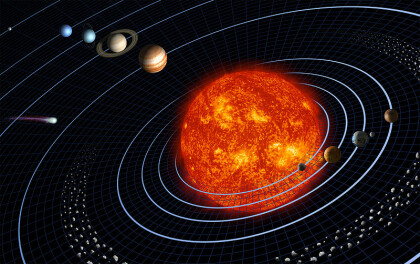 Image courtesy of NASA, used under Public Domain (http://en.wikipedia.org/wiki/File:Solar_sys.jpg)
Image courtesy of NASA, used under Public Domain (http://en.wikipedia.org/wiki/File:Solar_sys.jpg)
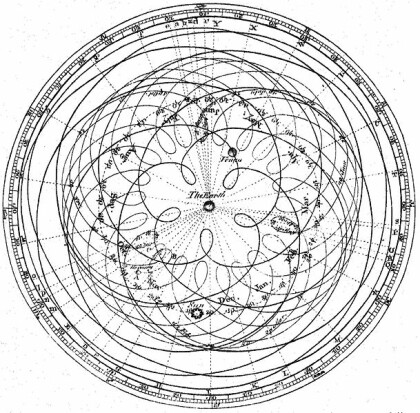
Image courtesy of Encyclopedia Brittanica (1st Edition), used under Public Domain (http://en.wikipedia.org/wiki/File:Cassini_apparent.jpg)
At least as early as Ancient Greece, people realized that the positions of objects in the night sky change with time and began to plot these motions. The unique motion of the planets soon made it clear that they must all orbit around some central object. Since our day to day experience suggests that Earth is stationary, it seemed clear that Earth must be what everything else orbits. This understanding of the solar system is known as the geocentric model.
The philosophers and scientists of Ancient Greece were fascinated by astronomy and considered circles to be the perfect shape. They also believed that the heavens were a place of perfection. Therefore, they assumed that the planets must follow circular paths around Earth. Because reason was considered more important than observation, there was little attempt to justify these conclusions with data.
Claudius Ptolemy, an Egyptian astronomer who lived in the 2nd century, carefully plotted the motion of the planets and realized that simple circular orbits around Earth could not completely explain the motion of the planets. He added called the primary orbit around Earth the deferent, but also added epicycles. In Ptolemy's model, the epicycles are smaller, circular paths each planet follows as it also travels along the deferent. This combination of deferents and epicycles, known as the Ptolemaic model, stood for several centuries.
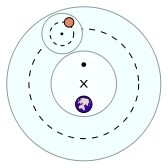
Image courtesy of Fastfission on Wikimedia Commons, used under Public Domain (http://en.wikipedia.org/wiki/File:Ptolemaic_elements.svg)
The Copernican Revolution
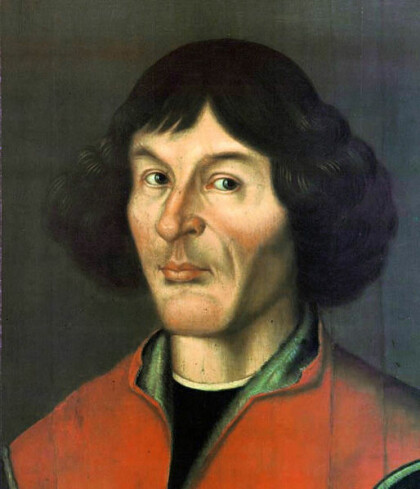
Image courtesy of Wikimedia Commons, used under Public Domain (http://en.wikipedia.org/wiki/File:Nikolaus_Kopernikus.jpg)
By the Renaissance, the church had become a powerful entity, able to direct the decisions of even the most powerful kings. The church of the day was also deeply committed to the geocentric model. Theologians argued that the Bible clearly shows mankind plays a central role in creation, so Earth must be placed at a central location in creation.
Into this world came Nicolaus Copernicus, a Polish astronomer born in 1473. He began to realize Ptolemy's geocentric model did not quite fit his observations and began revising it. To maintain a geocentric system, Copernicus realized he needed epicycles on epicycles and the system quickly became incredibly complicated. Eventually, he realized he could match his observations much more simply by placing the sun, rather than Earth, at the center.
He showed a few friends his book On the Revolutions of Celestial Objects, which laid out his arguments in favor of a heliocentric model and they encouraged him to publish this work. The start of the Protestant Reformation a few years earlier had weakened the church and made it possible to question their tenets, but Copernicus still feared the repercussions of publishing his book. As Copernicus directed in his will, the book was finally published shortly after his death and the recent invention of the Gutenberg press allowed it to spread far and wide.
Tycho & Kepler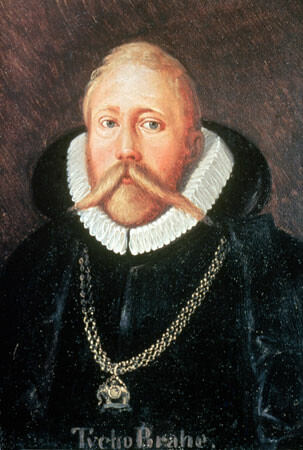
Image courtesy of Wikimedia Commons, used under Public Domain (http://en.wikipedia.org/wiki/File:Tycho_Brahe.JPG)
To fight the Copernican Revolution, the church realized they needed data and a theory more compelling than what Copernicus had written. This made Tycho Brahe one of the most powerful weapons in the fight. His observatory in Amsterdam had the most impressive equipment of the day, allowing Tycho to make unprecedented observations of the motions of Mars.
Based on these observations, Tycho produced his own model of the solar system, known as the Tychonic system. In his model, the sun orbited Earth, while the rest of the planets orbited the sun. This model did not require any epicycles, making it much simpler than the straight geocentric models, while still placing Earth at the center of the solar system.

Image courtesy of Fastfission on Wikimedia Commons, used under Public Domain (http://en.wikipedia.org/wiki/File:Tychonian_system.svg)
Tycho's assistant, Johannes Kepler, was not convinced by the Tychonic model and began working on his own version of a heliocentric model using Tycho's observations of Mars. In his first version, Kepler attempted to maintain the central role of geometry. He placed the sun at the center, then based the radius of the planets' orbits on the Platonic solids, the set of three-dimensional shapes where all the sides have equal lengths.
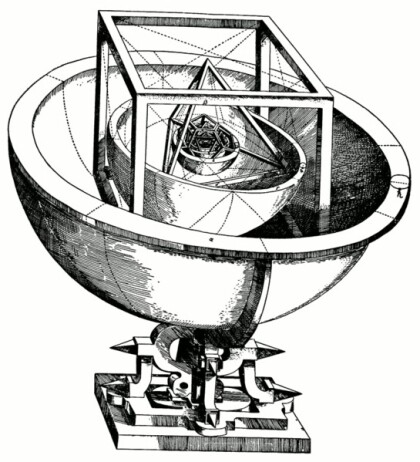
Image courtesy of Wikimedia Commons, used under Public Domain (http://en.wikipedia.org/wiki/File:Kepler-solar-system-1.png)
It did not take long for Kepler to realize this model did not correctly fit Tycho's data. He finally developed three laws, now known as Kepler's Laws, which place the Sun at the center of the solar system and give the planets elliptical, rather than circular, orbits. While Kepler's Laws are still used today, it was not until later that anyone could explain why his laws must be true.
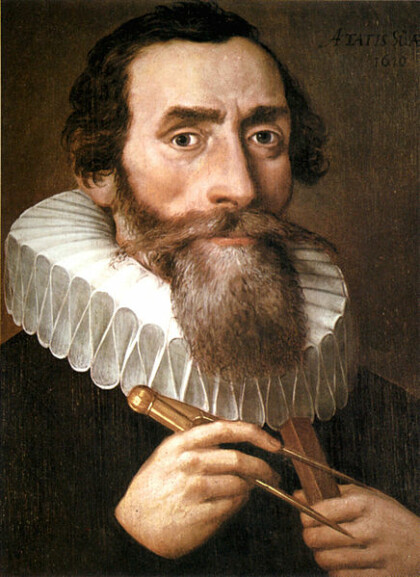
Image courtesy of Wikimedia Commons, used under Public Domain (http://en.wikipedia.org/wiki/File:Johannes_Kepler_1610.jpg)
Galileo & Newton
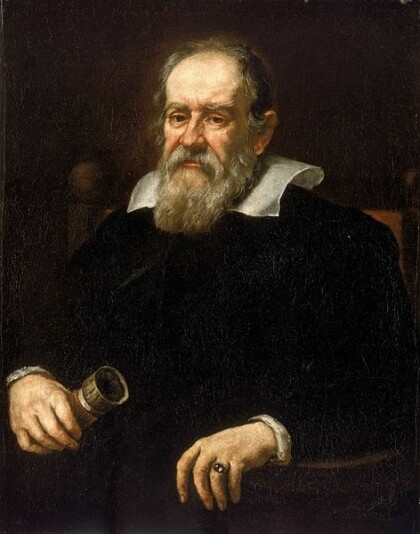
Image courtesy of Wikimedia Commons, used under Public Domain (http://en.wikipedia.org/wiki/File:Justus_Sustermans_-_Portrait_of_Galileo_Galilei,_1636.jpg)
Galileo was a contemporary of Kepler's and was the first person to turn a telescope to the night sky. In his book The Starry Messenger, Galieo recorded some of his most important observations, including the moons of Jupiter. When Kepler's theory was published, Galileo saw it as an incredible leap forward and the only theory which could truly explain his observations, as well as Tycho's. Galileo became a tireless promoter of Kepler's theories, ending his life under house arrest for heresy as a result.
In 1642, Galileo died and Isaac Newton was born. 50 years after Kepler published the first of his laws, Newton published his Law of Universal Gravitation, finally explaining why Kepler's Laws must be true.
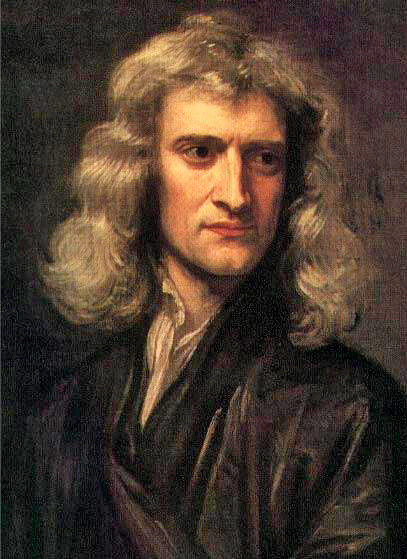
Image courtesy of Wikimedia Commons, used under Public Domain (http://en.wikipedia.org/wiki/File:GodfreyKneller-IsaacNewton-1689.jpg)
Edmond Halley, best known for his observations of Halley's comet, issued a challenge for someone to prove Kepler's Laws. Newton realized his observations of gravity on Earth should also be able to explain the motion of the planets and performed the calculations to prove it. At Halley's urging, Newton eventually published his calcuations in a book known as Philosophiae Naturalis Principia Mathematica. For the first time, someone sucessfully argued that the same laws governed the motion of both earthly and celestial objects and physics became a set of universal rules.
Learn MoreThis is a very brief introduction to an incredibly important story in the history of science. If you'd like to learn more, try some of these resources.
The Copernican Revolution by Thomas S. Kuhn Discoveris and Opinions of Galileo by Galileo Galilei The Clockwork Universe by Edward Dolnick The Galileo Project from Rice University (http://galileo.rice.edu/) ImprintPublication Date: 04-07-2014
All Rights Reserved





Comments (0)